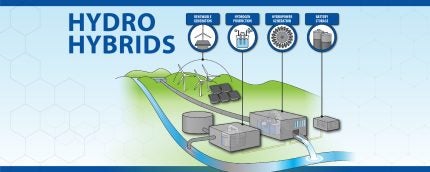
Utility-scale batteries may significantly enhance the reliability of hydropower, a study from the Idaho National Laboratory (INL) suggests. These batteries, commonly paired with solar and wind power, can store excess energy produced during low-demand periods, which can then be used when demand rises. Despite hydropower accounting for 29% of renewable energy in the U.S., research on the benefits of “hydro-hybrids”–hydropower plants that use battery storage – is limited.
“There’s a lot of environmental constraints and procedures that go into building a new dam,” said Venkat Durvasulu, a power systems engineer at Idaho National Laboratory (INL). “Hydropower is not growing as quickly as wind and solar, and most of the hydropower studies are about expanding existing infrastructure. We believe coupling battery storage with hydroelectric plants should be studied more because water is so important, and we want to use it sustainably. Adding batteries helps with that.”
Durvasulu and his team, funded by the Department of Energy’s Water Power Technologies Office, recently explored the benefits of hydro-hybrids in a study published in Renewable and Sustainable Energy Reviews.
Advantages of hydro-hybrids
“Batteries offer all kinds of benefits like reduced cost of maintenance, increased production, and investment and production tax benefits,” noted Hill Balliet, a power systems engineer at INL and co-author of the study. Hydro-hybrids also offer a key advantage over wind and solar due to their predictability. While wind and solar outputs can fluctuate, hydropower operators can control water flow, particularly those with reservoirs.
“With solar and wind, you’re tied to the forecast, which isn’t always predictable,” Durvasulu said. “With hydropower, it’s possible to calculate a few days out roughly how much water will be coming downstream, and hydropower owners can get a good idea of how much power they can generate.”
This predictability allows hydro-hybrids to make efficient use of the plant’s interconnection “headroom,” or the margin between a plant’s production and the grid’s rated connection. Using this headroom reduces costly interconnection upgrades and regulatory assessments.
“Hydro-hybrids store excess power when headroom goes down and put more into the grid when it goes up,” Balliet explained. “Not only that, but adding batteries can make relicensing much easier.”
Additionally, hydro-hybrids are capable of restarting the grid following blackouts. “If you add a battery to a hydropower plant, you can start up from a blackout and supply power to critical services, like police, fire stations, and hospitals, which isn’t feasible with solar and wind,” Balliet said.
Environmental and operational challenges
Hydropower operators must consider impacts on downstream communities and ecosystems, including other hydropower plants, local water users, indigenous populations, and wildlife. Durvasulu emphasized the importance of environmental stewardship, stating, “Rivers are essential to life and are associated with the heritage of many indigenous populations. Federal agencies need to ensure the river ecology is preserved. If not properly maintained, hydropower plants can affect the oxygen content and temperature of water downstream, which can contribute to ecological damage.”
Meeting these environmental requirements can be costly, accounting for 5% to 10% of hydropower production costs. Utility-scale batteries help by providing power from stored energy when the plant cannot fully utilize river flow during peak demand periods.
“Batteries add a level of flexibility that can help hydropower operators meet the needs of all the various groups that rely on water,” Balliet said.
Barriers to further research
One barrier to adopting hydro-hybrids is that existing models often overlook potential cost savings, such as reduced maintenance, improved grid stability, tax credits, and carbon credits. To address this, Durvasulu, Balliet, and their team developed “Hydro + Storage Sizing,” an online tool that estimates the profitability of different battery sizes by considering these avoided costs.
“There are other untapped values and opportunities too,” Balliet added, “more jobs, improved load-carrying capacity, lower operational and environmental costs, better water management, and greater profits.”
Without such tools, decisions about hydro-hybrid adoption may miss opportunities to enhance the value of hydropower for plant owners, the grid, stakeholders, and the environment.
“At the end of the day, it’s about the ecology and management of water,” Durvasulu said. “You have to make money to stay in business, but you have to balance that with all the other living things that rely on the water, and batteries help with that. We want to ignite that idea; it’s important to think about those kinds of things.”
Based on an article published by Brandon Hallmark at Idaho National Laboratory






